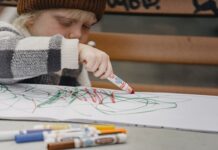Dyslexia usually appears at an early age, so it is good to be able to detect it early, thus facilitating learning for our children and normalizing this condition in such a way that they lead a completely normal life There are several symptoms in the development of a child that will help us detect this problem early, but only a specialist can diagnose it. We know that if a child with dyslexia is detected many things can be done for him and to facilitate learning, so keep reading and do not miss the detail of this article in which we are going to explain how to help a child with dyslexia, whether at home, at school or anywhere in their usual environment.
There are several symptoms in the development of a child that will help us detect this problem early, but only a specialist can diagnose it. We know that if a child with dyslexia is detected many things can be done for him and to facilitate learning, so keep reading and do not miss the detail of this article in which we are going to explain how to help a child with dyslexia, whether at home, at school or anywhere in their usual environment.
Index
- Possible causes and tests to detect dyslexia in children
- What to do to help a dyslexic child
- Phonological awareness exercises for dyslexic children
Possible causes and tests to detect dyslexia in children
The possible causes of dyslexia are not entirely clear scientifically but, in recent years, the results of the numerous studies carried out suggest that genetics play a very important role in this condition and that physiological causes such as problems in the auditory system or Eye diseases are also quite common causes of dyslexia.
In addition, it is very important that if we begin to suspect that a student or our child may have this problem, we immediately do tests and trials to be able to detect whether it is dyslexia or another type of condition. This way we will detect it in time to find the best possible solution and help and we will greatly facilitate the development and learning of the child. For example, you can read aloud with the child and pay attention to how his reading develops and what kinds of mistakes he makes or you can also do circuits and activities that help you observe his balance and coordination.
What to do to help a dyslexic child
There are many ways to help a child with dyslexia, from making him understand that it is something that many more people experience and is not serious at all, to facilitating learning and development through some exercises and activities that will help him improve. little by little their reading, writing, expression and communication in general. It is very important to go to a specialist to help us know what may be the best way to face this challenge according to the type and degree of dyslexia that the child suffers and according to his character. Likewise, it is vital that there is coordination between the school in which the child studies and their home, in order to carry out exercises and complementary activities and inform each other of the evolution of the situation. Some of the activities that the child should try to carry out in any environment are the following:
- Phonological awareness exercises
- Psychomotor activities and circuits
- Daily reading aloud and writing
- Short-term memory games
- Activities and games with more children
In addition to doing several of these activities, it is very important to be positive on the part of everyone around the child and psychological support from a specialist if necessary. It is a fact that many children can suffer rejection by others due to having a different learning rhythm or, separating themselves from other children, so it is helpful that from the beginning there is a psychologist who supports the child affected by dyslexia for as long as it takes.
Phonological awareness exercises for dyslexic children
The exercises of phonological awareness help in the processes of decoding and reading comprehension, improving the ability to represent and mentally use the different sounds of language and exercising memory. Here are some of the phonological awareness exercises most indicated by specialists to help a child with dyslexia to improve their skills every day:
Phonemic awareness exercises
- Detect what sound or letter is missing in a word that we indicate.
- Segment phonemes or letters and tell us how many there are.
- Indicate which letter or phoneme is repeated in a series of words, which is the letter that relates them or mark all the pictures or images that have the same letter or, on the contrary, ask them to say which one of a group of images they are it is out of place because it has no phoneme in relation to the rest.
- Order letters to make words.
- Complete words with only one letter missing.
- Ask the child to spell a word or ask him to write the words that you spell for him, indicating the sound of each letter and not its name.
Lexical awareness activities
- Separate the words of a sentence written without spaces and indicate how many there are.
- Substitute and change words at different positions in a sentence to see what the result is.
- Ask him to write sentences with a specific number of words and with a couple or more specific words.
- Omitting words in sentences and becoming aware of the lack of meaning in the result.
Syllabic awareness exercises
- Ask him to indicate how many syllables a word has and what they are.
- Omit syllables in some words so that the child can detect which syllable is missing and indicate it, or ask him to remove specific syllables from a series of words.
- Ask you to mark the syllables that are the same in a group of words
- Substitute syllables, either the child identifies the one we ask him to change and replaces it with the one we indicate or, we give him a list of words with some syllables already changed so that he can identify and correct them.
- Ask him to order the syllables we teach him to make words.
- Play the chain of syllables starting with you with a word and have the child continue with another word that begins with the last syllable of which you have said and so on.
- Games and activities to make rhymes with the last syllables of each word or verse.
This article is merely informative, we do not have the power to prescribe any medical treatment or make any type of diagnosis. We invite you to see a doctor in the case of presenting any type of condition or discomfort.




